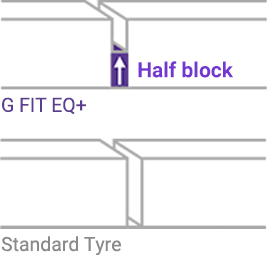Tyre pressure
The tyre inflation pressure is directly related to safety. Therefore, tyre pressure must be checked regularly, and proper maintenance can prolong the lifespan of the tyres. Learn about the importance of tyre inflation pressure and how to check the pressure of your tyres.
Importance of tyre pressure
- Optimum air pressure should be maintained to ensure safety, driving performance, tyre life and fuel cost.
- Tyres have been known to lose up to one psi in a month (psi: pound per square inch) Therefore, it is important to check all tyres, even the spare, at least once a month or before a long trip.
Recommended interval
Tyre pressure should be checked every month.
Checking for optimum tyre pressure
Laufenn tyre recommends you to check your tyre pressure once in a month.
The optimum air pressure level for your tyre can be found on the inner side of the car door (on the tyre placard), inside the fuel cap or in the car manual (the location of the sticker can vary according to country).
DO NOT compare your inflation pressure to its maximum pressure marked on the tyre’s sidewall.
How to check tyre pressure
1. Purchase a certified air pressure gauge or take your vehicle to a nearby service centre for a check-up.
2. Tyres must be checked in a “cold” state (at least three hours after driving).
3. Insert the gauge into the valve.
4. Compare the measured air pressure level with the level listed on the tyre placard.
- If the measured figure is higher, release air until the figure matches what is listed on the tyre placard.
- If the measured figure is lower, insert more air until the figure matches what is listed on the tyre placard.
Maintenance
Tyre wear directly affects the driver’s safety and the performance of the vehicle. It is essential for the driver to be well-informed about how to check for tyre wear regularly.
Importance of checking for tyre wear
The deeper the groove, which is on the surface of the tyre, the more grip a tyre will have. You can prevent danger of unexpected accidents by checking for tyre wear on a regular basis.
Recommended interval between check-ups
Laufenn tyre recommends that you check for tyre wear once a month. Also, make sure to do a check once more after long distance travel.
Checking for tyre wear with tyre tread wear indicator
You can check for the depth of the groove by using a tyre tread depth gauge or by observing the tread wear indicator on the side of the tyre. To ensure optimum safety and performance, tyres should be replaced when the tyre groove wears below 2mm to 3mm.
Rotation
Periodic rotation prevents uneven wear, prolonging the life of your tyres. Learn about the importance of tyre rotation and how to rotate them.
The importance of tyre rotation
Periodic tyre rotation helps extend the life of your tyres and improve performance level. For your safe driving and saving money, please refer to the rotation method below.
When to rotate your tyres
In general, it is the best to rotate tyres every six months or 10,000km. To change tyre position to the other position ensure even wear and long life of tyre.
Balance
Tyre balance must be checked if there is unexpected vibration or noise from a tyre. Learn about the importance of tyre balance, which is necessary for a comfort driving experience and when to inspect a balance.
The importance of tyre balance
Tyre balancing is a process of compensating for the weight of the tyre and wheel after assembly. If not properly balanced, it increases vibration and cause stress on your vehicle.
When to inspect for tyre balance
If you feel a vibration from a tyre, visit a mechanic where he or she will attach a balancing weight to the exterior or interior of the wheel to counteract centrifugal forces acting on the heavy areas when the wheel is turning.
How to balance tyre and wheel
To balance the tyre and wheel assembly, a balance weight can be used when a certain spot is lighter or heavier than it should be.
Wheel alignment
To prevent vibration, skidding, noise, and wear, wheel alignment inspection is necessary. Learn about useful information regarding wheel alignment and how to perform an inspection.
The importance of wheel alignment
The purpose of wheel alignment is to adjust front-wheel handling while driving. If wheel alignment is off, tyre life is shortened while car and mileage performance also decrease.
When to check wheel alignment
Laufenn tyre recommends to inspect wheel alignment every year or for every 20,000km. The inspection is required
- after a car accident.
- after tyre replacement.
- when there is uneven wear on a shoulder.
- when the steering wheel is unstable and/or vibrating
- when riding is uncomfortable or fuel efficiency gets worse
Replacement
In order to ensure a safe and comfortable ride, it’s strongly recommended all driver to know when and how to replace tyres.
The importance of tyre replacement
Timely replacement of tyre is critical for driver safety and also influences vehicle lifespan and performance.
When to replace a tyre
- In case of severe tyre erosion.
- In case repair is impossible due to tyre puncture.
How to replace a tyre
In the case of a damaged tyre and wheel, professional consultation is recommended. Tyre replacement should only be done by a trained and highly experienced technician.
Tips for tyre replacement
- It is the best to replace two tyres on one axle at the same time.
- Only replacement of one tyre of two on the same axle usually causes to unbalance the vehicle.
![]()










